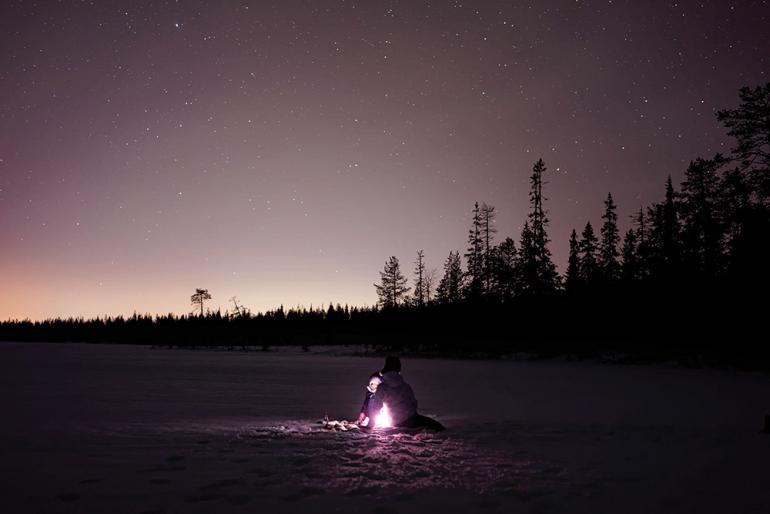Cold, Calm & Collected
Tips on winter survival.
By failing to prepare, you are preparing to fail.—Benjamin Franklin
These days, the word “adventure” gets tossed around so willy-nilly that it’s become marketing jargon for kids’ summer camps. But what it used to mean—and what it still implies—is uncertainty, danger, and risk. It suggests that somewhere along the way, things may stray from the original plan. And in the winter, an adventure can have even more serious stakes—which, of course, is part of what makes it so appealing. Here are some tips and tricks for dealing with this season’s backcountry risks.
Building a Fire on Snow
If there’s one thing that can save you on a cold night in the woods, it’s the ability to start a fire in the snow. When things go wrong in the winter, it’s almost always the first thing you’ll have to do.
Materials. Dry tinder isn’t as easy to find during the winter as in the summer, so pack your own. Reliable firestarters include multiple lighters, candles, petroleum jelly, and dryer lint.
Location. Pick a spot that’s out of the wind and sheltered from rain or snow. Knock snow off the branches above you before starting.
Create a Pit. Dig down to hard earth. If the snow is too deep, dig at least a foot down and build a platform of rocks or sticks to ignite the tinder on.
Be Prepared. Before starting, collect enough dry sticks to create a bed of coals. Don’t run out of wood before the thing gets going, or worse, have it die out when you go to collect more.
Word to the Wise. If you have to spend the night, heat rocks and bury them under your sleeping pad. The heat will rise and warm you from below—just make sure to put enough dirt down so as not to burn yourself.
Hypothermia Dos & Don’ts
Without a doubt, one of the most common backcountry ailments in the winter is hypothermia. Learn to identify the early stages, because once the body’s core temperature drops significantly, things go south quick.
DO routinely check in with your partners to see how they’re feeling on cold days.
DON’T assume everyone else is warm just because you feel good.
DO drink just as much water as you would in the summer.
DON’T stop drinking water just because you’re not thirsty. Dehydration drastically increases the chances of hypothermia.
DO warm hypothermic patients gradually.
DON’T warm patients too quickly (such as a hot bath), as the intense heat flux can be stressful on the heart and lungs.
DO give hypothermic patients warm non-alcoholic drinks like tea.
DON’T pass your hypothermic friend the flask. Alcohol hinders the warming process.
How to Dig a Snow Cave
1. Select a spot with plenty of snow, away from avalanche terrain.
2. Make a mound, six feet or higher, in a circle with a ten-foot diameter (or larger if you have more than two people).
3. Pack the pile firmly—especially if the snow is light and dry.
4. Let the mound settle before you dig in. The longer you wait, the less likely your roof is to collapse.
5. At the base of the mound, dig a tunnel into the snow pile. To funnel cold air out, make the floor of the cave, or at least a sleeping platform, slightly higher than the top of the entrance.
6. Stick tree branches 12-18 inches into the top of the mound to act as a guide for when to stop hollowing out the cave. The sides should be considerably thicker.
7. If it’s below freezing and you have a source of water nearby (e.g., a running creek), pour some on the outside of the cave for an extra layer of insulation.
8. Once the cave has solidified completely, poke holes through the sloped edge of the roof for extra ventilation.













